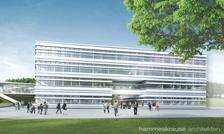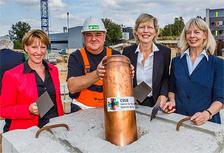Exterior view of the CSSB building (picture hammeskrause architekten).
A unique interdisciplinary centre for the investigation of pathogenic organisms is currently taking shape on the DESY campus – the Centre for Structural Systems Biology CSSB. Nine partners – the majority universities and research institutes from northern Germany - have joined forces to decipher exactly how viruses, bacteria and parasites attack their hosts at the atomic level with the help of DESY's X-ray sources and other research methods. This will form the basis for the development of custom designed pharmaceuticals. Together with representatives of the CSSB partners, Hamburg's science senator Dr. Dorothee Stapelfeldt, secretary of state in Lower Saxony's science ministry Andrea Hoops and CSSB founding director Dr. Matthias Wilmanns today laid the foundation stone for the centre's new research building.
“With the Centre for Structural Systems Biology we want to climb up into the champion´s league of structural biology research,” said Dr. Matthias Wilmanns, scientific director of the CSSB and head of the Hamburg unit of the European Molecular Biology Laboratory (EMBL). “The new building situated in direct proximity to state-of-the-art research light sources will offer an excellent environment to carry out interdisciplinary research with novel methods.”
“The CSSB bridges the gap between physical basic research and the life sciences,” says Hamburg's science senator Dr. Dorothee Stapelfeldt. “The CSSB is an additional building block in our plan to further establish Hamburg and the research campus Bahrenfeld as a leading international location for structural research and to develop existing cooperations. The CSSB has already attracted outstanding international scientists. It is an important signal that the north German states are working closely together and actively supported by the federal government. My thanks go to all partners of this project.”
“The foundation stone for the CSSB is a milestone on the way to united structural biology research in north Germany. The new interdisciplinary research centre brings together existing strengths, makes them visible and opens up new possibilities across state borders to do research in this important field,” said Andrea Hoops, secretary of state in the ministry for science and culture in Lower Saxony.
In the CSSB biologists, chemists, medics, physicists and engineers will investigate the interplay between pathogenic organisms and their hosts. The scientists have access to the unique light sources at DESY which offer optimal conditions for structural biology research. With the use of “supermicroscopes” such as PETRA III and the future European XFEL, the researchers can investigate biological samples in various ways – from the structure analysis of single molecules to the real time representation of processes in living cells – and analyse the molecular basis of diseases with extremely high spatial and temporal resolution. By combining this with methods such as cryo-electron microscopy, carried out by leading specialists in this field, CSSB offers unique research opportunities, for example the decoding of the interplay of proteins during infection processes. A typical research question could be how the malaria parasite enters the red blood cells – an extremely complex procedure involving a large number of proteins.
Christian Scherf, administrative director at DESY, welcomes the development of strong structural biology partnerships on the DESY campus: “CSSB will strengthen the international visibility and dynamics of the Bahrenfeld research campus enormously.”
The CSSB was officially launched at the beginning of this year. From a total of eleven planned (junior) research groups, six have already been established. The CSSB has been successful in attracting top researchers from, amoung others, Canada, Austria and Great Britain for these appointments.
The new joint research building, for which the foundation stone was laid today, was designed by the architects Hammes and Krause. The three storey laboratory and office building will offer around 11000 square metres of space for 180 scientists. The ca. 2800 square metres of lab space will be equipped with state-of-the-art instruments such as electron microscopes. Up to one fifth of the CSSB will be reserved for junior groups and guest researchers. The building is scheduled to be opened in about two years time. The investment costs of ca. 50 million Euros are divided between ca. 38 Million Euros for the building and 12 Million Euros for scientific equipment. The federal government carries 73% of these costs, Hamburg 17% and Lower Saxony 10%.
CSSB research partners
Bernhard-Nocht-Institut für Tropenmedizin
Deutsches Elektronen-Synchrotron DESY
European Molecular Biology Laboratory EMBL
Forschungszentrum Jülich
Heinrich-Pette Institut für Experimentelle Virologie und Immunologie
Helmholtz-Zentrum für Infektionsforschung
Medizinische Hochschule Hannover
Universität Hamburg
Universitätsklinikum Hamburg-Eppendorf
(from DESY Press Release)








